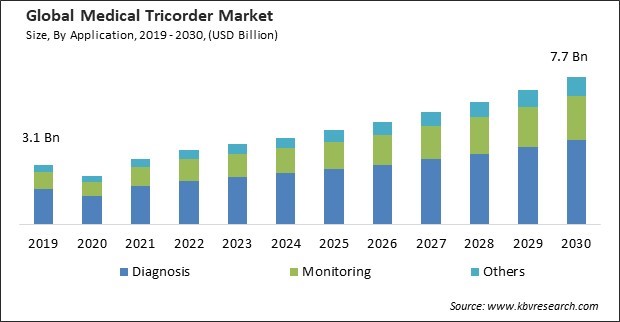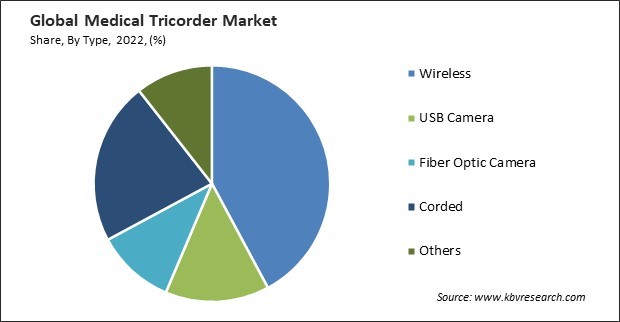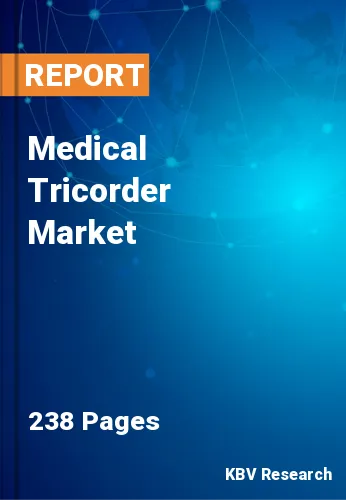The Global Medical Tricorder Market size is expected to reach $7.7 billion by 2030, rising at a market growth of 9.1% CAGR during the forecast period.
Medical tricorders have become more sophisticated, accurate, and user-friendly as technology advances. European consumers and healthcare providers are increasingly interested in adopting these cutting-edge devices to improve patient care and health monitoring. Therefore, the European region would account for 2/5th share of the market by 2030. The rise of telemedicine and telehealth services in Europe has created a demand for tools that enable patients and healthcare providers to collect and share medical data remotely. Owing to these aspects, there will be a rise in demand in the Europe segment. Some of the factors impacting the market are rising technological advancements in medical devices, increasing proactive engagement of patients in managing their health, and strict regulatory requirements and the process of obtaining approvals.

Advances in sensor miniaturization have allowed for integrating various sensors into small, handheld devices. This includes sensors for measuring temperature, blood pressure, heart rate, and oxygen levels. These sensors are now compact, highly accurate, and energy-efficient. Modern sensors can detect subtle physiological parameter changes, making them suitable for clinical use. They can provide accurate measurements in real-time, which is crucial for monitoring health conditions and diagnosing illnesses. Tricorders can collect, process, and display health data in real-time, enabling immediate feedback to healthcare providers and patients. This real-time capability is crucial for making rapid clinical decisions and adjustments in treatment plans. Additionally, the need for devices and technology that help people track their health is growing as people take greater ownership of their health and well-being. Medical tricorders cater to this demand by providing a user-friendly, at-home health monitoring solution. Medical tricorders empower individuals to monitor their vital signs and health parameters regularly. This early detection of potential issues can lead to timely interventions and better health outcomes. With individuals actively using medical tricorders, a wealth of data is available for analysis. This data can be integrated into electronic health records, providing a more comprehensive view of a patient's health history. It can also enable personalized healthcare recommendations and interventions based on the individual's unique health data. Owing to these factors, the demand for medical tricorders will increase.
The pandemic disrupted global supply chains, impacting the production and distribution of medical tricorders. Delays in component sourcing and manufacturing occasionally hampered the availability of these devices, affecting healthcare facilities' ability to access this technology. Moreover, the need for remote patient monitoring and diagnosis became more apparent during the pandemic, as healthcare facilities faced significant challenges in managing and treating COVID-19 patients. With their ability to remotely collect and transmit diagnostic data, medical tricorders saw increased demand to monitor patients without direct contact, reducing the risk of virus transmission. The urgent need for rapid and accurate diagnostic tools to identify COVID-19 cases also prompted innovation in the market.
However, the regulatory approval process can be time-consuming, often taking several years. This can significantly delay the development and commercialization of medical tricorders, slowing the introduction of new and innovative devices to the market. Complying with regulatory requirements often requires extensive testing, clinical trials, and documentation. These activities can significantly increase development costs, ultimately passed on to consumers through higher device prices. Small and innovative startups may face substantial challenges entering the market due to the high costs and complexities associated with regulatory approval. This can limit competition and innovation within the market.
Based on application, the market is segmented into monitoring, diagnosis, and others. The diagnosis segment held the largest revenue share in the market in 2022. Medical tricorders have evolved to incorporate sensors capable of measuring vital signs and parameters. These sensors include electrocardiography (ECG), temperature, blood pressure, and respiratory rate. Integrating multi-modal sensors enhances tricorders' diagnostic capabilities, allowing for comprehensive health assessments. The integration of nanotechnology and lab-on-a-chip technology has revolutionized diagnostics. Medical tricorders can now detect diseases, pathogens, and biomarkers with exceptional sensitivity at the molecular level. This level of precision enables early disease detection and monitoring, significantly improving patient outcomes. Therefore, these factors will boost the demand in the segment.
By type, the market is divided into wireless, USB camera, fiber optic camera, corded, and others. In 2022, the corded segment acquired a considerable revenue share in the market. Corded tricorders offer higher accuracy and reliability due to the direct and consistent connection to power sources and data transmission. This can be crucial in medical diagnostics. Depending on the region, certain regulatory standards may require stringent data security and accuracy. Corded tricorders might be favored due to their compliance with such regulations. Corded tricorders have a continuous power supply and uninterrupted connectivity, eliminating concerns related to battery life or wireless connectivity issues. Wired connections can often provide faster and more stable data transfer speeds compared to wireless options. Therefore, these factors will boost the expansion of the corded segment.

On the basis of end-user, the market is divided into hospitals, clinics, and others. The hospitals segment recorded the maximum revenue share in the market in 2022. Hospitals and ambulatory surgical centers are keen on providing the best possible care to their patients. Medical tricorders offer improved diagnostic capabilities, allowing healthcare professionals to quickly and accurately diagnose various medical conditions. This technology is especially valuable in emergency rooms, where rapid diagnosis can be a matter of life and death. Medical tricorders can significantly streamline the workflow within healthcare facilities. They enable healthcare providers to collect diagnostic data rapidly and with minimal patient disruption. This efficiency is especially valuable in busy hospital settings and ambulatory surgical centers where time is often of the essence. Owing to these factors, there will be increased demand in the segment.
| Report Attribute | Details |
|---|---|
| Market size value in 2022 | USD 3.9 Billion |
| Market size forecast in 2030 | USD 7.7 Billion |
| Base Year | 2022 |
| Historical Period | 2019 to 2021 |
| Forecast Period | 2023 to 2030 |
| Revenue Growth Rate | CAGR of 9.1% from 2023 to 2030 |
| Number of Pages | 238 |
| Number of Table | 370 |
| Report coverage | Market Trends, Revenue Estimation and Forecast, Segmentation Analysis, Regional and Country Breakdown, Companies Strategic Developments, Company Profiling |
| Segments covered | Type, Application, End-User, Region |
| Country scope | US, Canada, Mexico, Germany, UK, France, Russia, Spain, Italy, China, Japan, India, South Korea, Singapore, Malaysia, Brazil, Argentina, UAE, Saudi Arabia, South Africa, Nigeria |
| Growth Drivers |
|
| Restraints |
|
By region, the market is segmented into North America, Europe, Asia Pacific, and LAMEA. The North America segment procured the highest revenue share in the market in 2022. The North American population is aging, leading to an increased demand for healthcare services. Medical tricorders offer a more efficient and convenient way to monitor health conditions, which can reduce the burden on healthcare systems. Medical tricorders are useful for ongoing surveillance of long-term conditions such as diabetes, high blood pressure, and heart disease. With a growing number of people living with these conditions, the demand for effective remote monitoring tools is rising. Therefore, the segment will witness increased demand in the future.
Free Valuable Insights: Global Medical Tricorder Market size to reach USD 7.7 Billion by 2030
The market research report covers the analysis of key stake holders of the market. Key companies profiled in the report include Healthy.io Ltd., Ionis Pharmaceuticals, Inc., Fujikura Ltd., Basler AG, Qualcomm, Inc., Hamamatsu Photonics K.K., Basil Leaf Technologies, DynoSense Corp, Cloud DX Inc., and QuantuMDx Group Limited.
By Application
By Type
By End User
By Geography
This Market size is expected to reach $7.7 billion by 2030.
Technological advancements in medical devices are driving the Market in coming years, however, Strict regulatory requirements and the process of obtaining approvals restraints the growth of the Market.
Healthy.io Ltd., Ionis Pharmaceuticals, Inc., Fujikura Ltd., Basler AG, Qualcomm, Inc., Hamamatsu Photonics K.K., Basil Leaf Technologies, DynoSense Corp, Cloud DX Inc., and QuantuMDx Group Limited.
The expected CAGR of this Market is 9.1% from 2023 to 2030.
The Wireless segment is leading the Market, by Type in 2022 thereby achieving a market value of $3.1 billion by 2030.
The North America region dominated the Market, by Region in 2022, and would continue to be a dominant market till 2030; thereby, achieving a market value of $2.6 billion by 2030.
Our team of dedicated experts can provide you with attractive expansion opportunities for your business.

